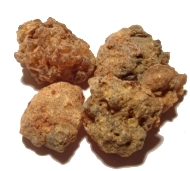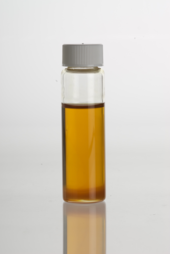Myrrh
Myrrh (/mɜːr/; from an unidentified ancient Semitic language, see § Etymology) is a gum-resin extracted from a few small, thorny tree species of the Commiphora genus, belonging to the Burseraceae family.
Myrrh mixed with posca or wine was widely used in many ancient cultures to produce pleasurable feelings and as an anti-inflammatory and analgesic.
[4] Commiphora myrrha is native to Somalia, Oman, Yemen, Eritrea, Somali Region of Ethiopia and parts of Saudi Arabia.
The word myrrh corresponds to a common Semitic root m-r-r meaning "bitter", as in Arabic مُرّ murr and Aramaic ܡܪܝܪܐ mureera.
[8] Myrrh gum has often been claimed to reduce the symptoms of indigestion, ulcers, colds, cough, asthma, respiratory congestion, arthritis, and cancer, although more good scientific evidence is needed to support these uses.
[11] The fifth-dynasty ruler of Egypt, King Sahure, recorded the earliest attested expedition to the land of Punt, the modern day Horn of Africa (particularly Somalia), whose members brought back large quantities of myrrh, frankincense, malachite and electrum.
In a relief from his mortuary temple celebrating the success of this expedition, Sahure is shown tending a myrrh tree in the garden of his palace.
Oil of myrrh is used in Esther 2:12 in a purification ritual for the new queen to King Ahasuerus: Now when every maid's turn was come to go in to king Ahasuerus, after that she had been twelve months, according to the manner of the women, (for so were the days of their purifications accomplished, to wit, six months with oil of myrrh, and six months with sweet odours, and with other things for the purifying of the women).Myrrh was recorded in the first century BC by Diodorus Siculus to have been traded overland and by sea via Nabatean caravans and sea ports, which transported it from Southern Arabia to their capital city of Petra, from which it was distributed throughout the Mediterranean region.
[14] Myrrh is mentioned in the New Testament as one of the three gifts (with gold and frankincense) that the magi "from the East" presented to the Christ Child (Matthew 2:11).
In the Middle East, the Eastern Orthodox Church traditionally uses oil scented with myrrh (and other fragrances) to perform the sacrament of chrismation, which is commonly referred to as "receiving the Chrism".
[15] The Encyclopedia of Islamic Herbal Medicine mentions the same hadith: "The Messenger of Allah stated, 'Fumigate your houses with al-shih, murr, and sa'tar.'"




